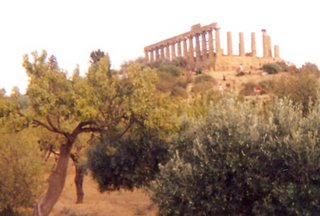Villa Romana del Casale
Mosaics
This fine villa, built either by Maxentius, Roman emperor 306-312 CE, or perhaps his son, is featured in an Ancient Life article in Archeology Odyssey magazine from some time ago, Premier Issue 1998 at page 72, see http://www.bib-arch.org/archaeology-odyssey.asp. The pity is the restriction to access archives -- how many of us are not about to join something else just for a look, and instead trust to the serendipitous finding of an issue or two. Another article is in March/April 2003 at pp.28 ff -- beautiful illustrations of these mosaics, "the most extensive collection of mosaics to have survived the destruction of the empire." Featured in the article, entitled Ferocious Elegance: The Cyclops, floor of the Vestibule of polyphemus, the "bikini girls" as shown here, a photograph of the villa itself, and the Room of the Small Hunt, and Corridor of the Great Hunt. These are realistic action depictions, not merely fluff to entertain. Need access to archives, magazine people.The information includes: area of mosaics? 38,000 square feet. Since the stones come from North Africa, it looks like skilled North African craftsmen were involved. Names of the rooms include the frigidaria, the cold baths. It is there that the bikini girls mosaic is found, in two rows. There is a handball game or exercise going on, and also the giving of prizes.
Since the other mosaics show daily life, such as the more familiar hunting scenes, dining, massages after the meal ("post-prandial" -- before the meal would be preprandial -- either way, nice idea), the women being athletic shows their regular fitness and competitions.
The kind of Roman latrine shown at Romana del Casale is common for Romans, see Archeology Odyssey May-June 2004 at p.53, article, Roman Latrines, How the Ancients Did Their Business, by Ann Olda Koloski-Ostro, illustrating facing lines of boards with holes and openways, a water channel at the sitter's feet for dunking the sponge on the stick used for cleanliness. And windows for good ventilation. A stone bowl, deep, holds all the sticked sponges, handles up, for repeated use. This arrangement is also apparently at Ephesus, more multi-seating facilities. Yet writings of the time reflect a coarser approach, dumping the equivalent of chamber pots out on the street, so more is to be learned.
 Roman Villa, near Piazza Armerina, Sicily
Roman Villa, near Piazza Armerina, Sicily Sicily's Ionian Riviera
Sicily's Ionian Riviera Ferry, Naples to Palermo, auto and cabin
Ferry, Naples to Palermo, auto and cabin Naples, cafe at the docks, waiting for the ferry to Sicily
Naples, cafe at the docks, waiting for the ferry to Sicily Palermo, Sicily. Cathedral
Palermo, Sicily. Cathedral Palermo, Sicily. Gate to City
Palermo, Sicily. Gate to City Baroque architecture, Sicily
Baroque architecture, Sicily Monreale Cathedral, Sicily
Monreale Cathedral, Sicily Monreale, Sicily, view
Monreale, Sicily, view Trapani, Sicily. Or is it?
Trapani, Sicily. Or is it?
 Greek Temple, Agrigento, Sicily.
Greek Temple, Agrigento, Sicily. Agrigento, Sicily, Greek Temple,set up for light and sound show
Agrigento, Sicily, Greek Temple,set up for light and sound show  Agrigento, Sicily, view of sea through Greek temple columns
Agrigento, Sicily, view of sea through Greek temple columns Selinunte, Sicily. Greek Temple
Selinunte, Sicily. Greek Temple